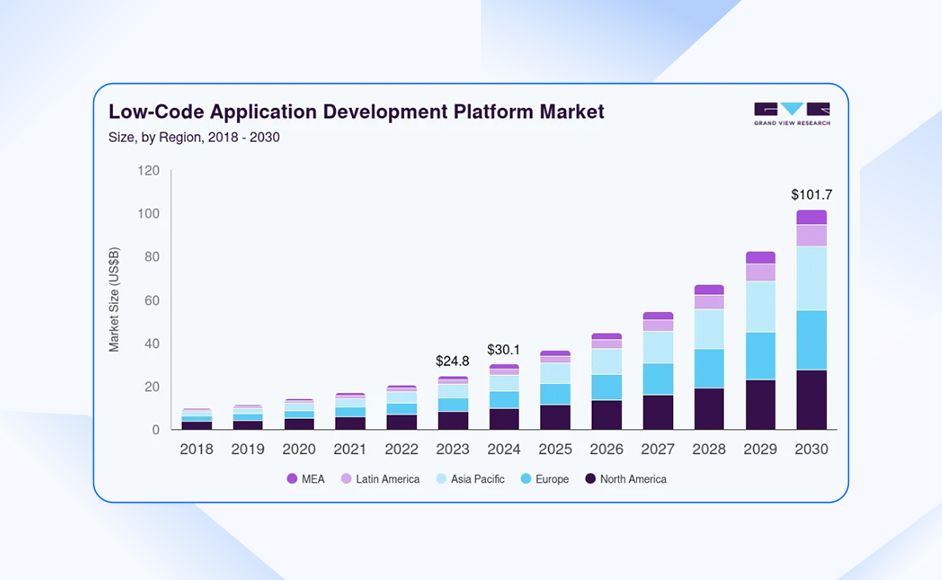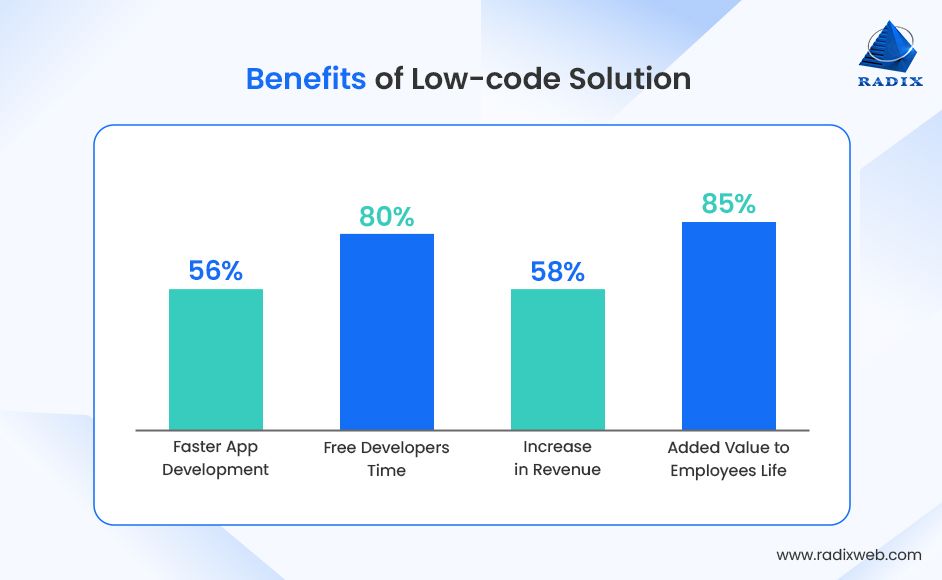Read More

Skip Setup Headaches and Start Your Project Fast - Download Free Boilerplates
ON THIS PAGE
- Market Growth of Low Code Platform
- Market Adoption Statistics for Low Code
- Importance of Low Code Development Solutions
- Benefits of Low-Code Development Benefits
- Legacy Modernization with Low Code Development
- AI and Automation Integration in Low Code
- Hybrid Team Productivity
- Low Code App Development Statistics to Consider
- Use Cases of Low-Code Development
- Industry Facts: Low Code Platforms
- Challenges of Low-Code Development
- Top Low-Code Platforms for App Development
- Experience the Magic of Low Code Development with Radixweb
ON THIS PAGE
- Market Growth of Low Code Platform
- Market Adoption Statistics for Low Code
- Importance of Low Code Development Solutions
- Benefits of Low-Code Development Benefits
- Legacy Modernization with Low Code Development
- AI and Automation Integration in Low Code
- Hybrid Team Productivity
- Low Code App Development Statistics to Consider
- Use Cases of Low-Code Development
- Industry Facts: Low Code Platforms
- Challenges of Low-Code Development
- Top Low-Code Platforms for App Development
- Experience the Magic of Low Code Development with Radixweb
Quick Summary: Low code is now mainstream as more and more companies are choosing convenience and flexibility over development complexities. To help you navigate through the buzz of this trend, we will explore a few low code statistics and trends for 2025 in this article. The facts and statistics will help you find the right solutions for your project needs.
The low code and no code revolution have moved beyond hype. It’s now a cornerstone of modern software development. With enterprise racing to modernize legacy systems, reduce IT backlogs, and empower business users, low code platforms are seeing a huge adoption rate. The market is projected to grow from USD 37.39 billion in 2025 to USD 264.40 billion by 2032, exhibiting a CAGR of 32.2% during the forecast period.
This blog is your way to the future of software development – low code. We will discuss its latest trends, statistics, and facts. We will also look at how low code is impacting businesses in 2025. Furthermore, we will go through some predictions for low code development and how it’s going to revolutionize the way we develop the software.
Let’s read without any ado.
Low Code Market Growth for 2025
- The global low-code development market is projected to reach $187 billion by 2030, up from $10 billion in 2019, growing at a rapid CAGR of 31%.
- As per Gartner, by 2025, 75% of large enterprises will leverage at least four low-code tools to support both IT-driven application development and citizen development projects.
- Gartner predicts that by 2026, over 75% of new enterprise applications will be built using low-code or no-code tools, up from 25% in 2020.
- Forrester estimates the low-code platform market will grow to $65 billion by 2027, fueled by enterprise modernization efforts.
- Fortune Business Insights values the global low-code market at $32 billion in 2024, with a CAGR of 28.8% projected through 2030.
- By 2025, 70% of new applications will be built using low-code or no-code technologies, a sharp rise from less than 25% in 2020.
- 41% of organizations already run citizen development programs, while another 20% are planning or evaluating initiatives.
- 79% of businesses develop a web application through citizen development within just one year.
- By the end of 2025, half of all new low-code platform customers will come from business units outside IT.
- Nearly 60% of custom applications are now created outside IT departments—30% of them by employees with little to no coding expertise.
Low Code Market Adoption Statistics for 2025

- The global low-code application development platform market is expected to reach $101.68 billion by 2030.
- Low code platforms will power 75% of new applications by 2026.
- Low code adoption is considered strategically important by 81% of companies.
- According to 40% of IT leaders, low-code will increase the diversity of their IT organization.
- 41% of organizations have active citizen development initiatives, and 20% of them are either evaluating or preparing to start citizen development initiatives.
- Within a year, about 79% of organizations create a web application using citizen development.
- Around 60% of all custom applications are developed outside the IT department. Employees with limited technical development skills and experience built 30% of those.
- 84% of businesses now use low code due to its capacity to lower the burden on IT resources, quicken time to market, and involve the company in the creation of digital assets.
- 31% of businesses employing low-code haven't created or delivered any of their most valuable applications using it.
- Prudent businesses are even more likely to prefer low-code for its process automation (67%), speed (63%), and flexibility (83%).
- For complicated business logic, 30% of businesses say they would rather utilize custom low-code in the future.
- Gartner expects that by 2025, non-technical users will account for 40% of all low-code platform users, up from 25% in 2023.
- According to Mendix, 98% of enterprises now use low-code platforms, tools, or features in their development processes.
- On average, 71% of organizations using citizen development report application delivery is at least 50% faster.
- As per Gartner forecast, by 2026, 80 % of low-code tool users will be outside of traditional IT departments (versus 60 % in 2021).
- According to Fortune Business Insights, the global low-code development platform market is projected to grow from USD 37.39 billion in 2025 to USD 264.40 billion by 2032, at a CAGR of 32.2 %.
- Straits Research projects a valuation of USD 38.84 billion in 2025, rising from USD 30.8 billion in 2024, with a compound growth rate of 26.1 % in the forecast period.
- 56 % of companies globally have already implemented low-code platforms.
- 81% of companies consider low-code development strategically important in their organizations.
- In analyses of low-code trends, it is noted that 81% of companies consider low-code development strategically important, especially in mature markets like the U.S. and Europe.
Importance of Low Code Development Solutions
Low code platforms allow users to build and deploy applications with little or no IT involvement. This makes an ideal solution for businesses to adopt this platform with minimal resources.
- 90% of app development time will be reduced using no code and low code development services.
- The worldwide low-code platform market is estimated to amount to nearly $65 bn by 2027.
- Over 65% of non-IT professionals will generate IT products and services by 2024, making up 80% of the total.
- Using low-code tools, the average company avoided hiring two IT developers. The applications created yielded an improvement in business value of around $4.4 million over three years.

- No-code solutions use 70% less resources than traditional app-building platforms.
- The IT and business teams collaborate on 59% of low-code projects.
- Low-code is a trend that 75% of IT professionals feel they can't afford to ignore.
- 41% of businesses already have active citizen development programs, while another 20% are planning or evaluating such initiatives.
- Companies report that low-code can cut development time by up to 90% and reduce costs by 45% or more.
- In fact, 79% of enterprises say low-code has lowered their operational costs.
- With global developer demand exceeding supply, low-code helps businesses continue innovating. By 2026, 80% of low-code users will come from outside IT departments, reducing reliance on scarce engineering talent.
- 73% of organizations agree low-code accelerates time-to-market, enabling faster prototyping, experimentation, and scaling of digital services.
- Modern low-code platforms offer enterprise-level integration and security, making them suitable not just for simple apps but also for mission-critical systems.
| Aspect | Traditional Development | Low Code Development |
|---|---|---|
| Time-to-Market | 6-12 months for enterprise apps | Week to a few months |
| Development Cost | High (full dev teams, infra) | Up to 45% of lower costs |
| Required Skill Level | Professional developers only | Business + IT users (citizen devs) |
| Adoption Rate | <30% of enterprises | 70% of new apps built with low/no-code |
| Primary Users | IT departments | Business units + IT collaborations |
| Business Impact | Slow, resource-heavy, costly | Faster innovation, reduces costs, agility |
Low-Code Development Benefits: Key Statistics for 2025
There are multiple benefits of low code development that businesses can leverage in 2025 -
- Business owners find low-code development platforms cost-effective with improved agility.
- 12% of low-code users claim that their app backlog has improved than before.
- 71% of enterprises using citizen development have accelerated application development by at least 50%, and 29% of businesses have witnessed a delivery time increase of two times or more.
- 90% of low-code platform users have less than five monthly app requests in their backlog.
- Business units were 21% happier using low-code solutions than among those not using low-code. So, this is a heads-up to leverage low-code platforms in 2024.
- 70% of low code users who used low code platforms for the first time had no prior knowledge and learned low code in a month or less.
- 72% of users are developing apps with low-code applications in less than 3 months.
- An annual average of 12 applications are created using a low-code development platform.
- In a recent Mendix survey, 80% of organizations reported that using low-code platforms boosts productivity.
- The same survey found 79% of enterprises experienced lower operational costs after adopting low-code.
- 73% believe low-code speeds up time-to-market. Nearly three-quarters of respondents say low-code tools help launch applications faster.
- 48% of leaders affirm low-code enabled faster app development.
- 45% say low-code directly reduced development costs.
- 90.4% of developers experienced productivity gain; 43.5% saved up to 50% time.
- According to the 2024 Reveal survey, 90.4% said low-code tools increased productivity; 43.5% reported saving up to half their development time.
- Many platforms claim development time reductions of up to 90% compared to traditional coding.
- In one case, firms reported cutting process durations by 40% through low-code initiatives, translating to millions in annual cost savings.
- 85% of employees say no-code tools create real value in their work.
- No-code platforms are up to 10× faster than traditional app development methods.
- Low-code solutions can cut enterprise application development time by as much as 60%.
- Companies using low-code for customer-facing apps see an average 58% boost in revenue.
- Organizations build applications 56% faster with low-code compared to traditional development.
- 80% of enterprises believe low-code frees developers to focus on business-critical projects.

- Around 29% of respondents said low-code is 40-60% faster than traditional development; another 29% reported speeds of 61-100% faster.
- As per research by KPMG, 56% of companies globally have already implemented low-code platforms. 53% of companies cited increased process efficiency, and 51% cited improved employee productivity as key benefits of low-code adoption.
- Professional developers see 50% faster deployment when using low-code / citizen development.
- Verified Market Reports estimates the enterprise low-code application platform market was valued at USD 6.67 billion in 2024, with strong growth projected into 2033.
- No-code / low-code platforms can reduce development time by up to 90% relative to traditional approaches.
- The guide also mentions that companies have avoided hiring two IT developers via no-code, saving USD $4.4M over three years.
- The same guide notes that cost reductions of 30–70% are commonly cited for no-code/low-code vs. traditional development.
- Using no-code, companies can shift from 6-month timelines to 2-week MVP development, enabling faster iteration of customer apps.
Low Code Development for Legacy Modernization
- Around 70% of software in many Fortune 500 firms is over 20 years old. That same report says 70% of banks globally still rely on legacy systems as of 2025.
- Legacy systems can consume over 55% of IT budgets, with some banks/insurers spending up to 75% just on maintenance.
- AI-driven modernization: a recent academic study shows an AI system converting COBOL to Java achieved 93% accuracy, reducing code complexity by 35% and coupling by 33%.
- Low-code/no-code modernization can “future-proof” legacy systems, improving performance, integration, and security.
AI and Automation Integration in Low Code
- AI integration in low-code platforms is predicted to generate over $50 billion in enterprise efficiency gains by 2030, with delivery times reduced by up to 70% compared to traditional methods.
- AI-driven low-code development reduces software delivery time by up to 70% and that AI integration enables low-code platforms to deliver apps 10× faster than traditional development.
- 65% of enterprises use AI in business functions, and no-code platforms increasingly incorporate intelligent automation.
- In an empirical evaluation (“Intuition to Evidence: Measuring AI’s True Impact on Developer Productivity”), 300 engineers over one year using an AI-assisted internal tool (combining code generation + review automation) achieved:
- 31.8% reduction in PR review cycle time
- 61% increase in code volume pushed to production (from top adopters)
- 28% overall increase in code shipped to production
- 85% of engineers reported satisfaction with the tool’s review features
Hybrid Team Productivity
- A report states that “the average company avoided hiring two IT developers” through use of no-code / low-code tools, saving USD $4.4 million over 3 years.
- No-code / low-code tools enabled many organizations to reduce reliance on IT teams, but specific percentage metrics are less clear.
- On hybrid / remote work (adjacent but relevant), a Stanford-led study found that hybrid work models “dramatically boosted retention rates” without harming productivity or promotions.
- In hybrid work statistics more generally, companies adopting hybrid models report workspace cost reductions of up to 40% per employee.
- Also, hybrid work can reduce turnover: some surveys show quit rates drop by up to one-third when hybrid models are implemented.
Low Code App Development Statistics You Need to Know in 2025
- After data science, IT is the second-largest spectrum where businesses are most likely to address skill gaps.
- In 2023, the average base salary of a software developer in the US was $117,820 annually. Though no code development solutions don’t completely replace developer functionality, they allow them to focus on more challenging projects.
- 82% of businesses confirm custom app development outside of IT is vital.
Low-Code Development Use Cases
- 58% of low code development is used to build forms or data-collection applications.
- Around 49% of applications that streamline business processes and workflows are developed using low code tools.
- 42% of developed low code applications replace paper, email, or spreadsheets.
- 22% of existing on-premises applications are redeveloped using low code platforms for better UI.
- Web apps are the most popular type of citizen development, with citizen developers creating an average of 13 apps.
- In a global study conducted by Statista, 33% of participants said their company uses low code for data modeling and visualization.
Low-Code Industry Facts
- There are around 223 low code platforms for development and 13 low code platforms for developing machine learning-driven solutions.
- 42 vendors providing PaaS (platform as a service)-primarily used low-code development tools.
- Based on data gathered from customer reviews for all low code/no-code development platforms firms, "ease of use" is the most frequently used (20%) positive word describing low code/no code development platforms.
- The word "clunky" is used to describe low code solutions the most negatively, and it appears in 5% of reviews for low code / no code development platforms.
Low-Code Development Challenges Statistics
Low-code development platforms offer rapid application development but face challenges like limited customization, scalability concerns, potential vendor lock-in, and security risks. Users may encounter difficulty in creating complex, highly specialized solutions, making them unsuitable for certain enterprise or mission-critical applications.
Here are some of the most critical statistics of challenges you might have to face for low-code development -
- Due to a lack of expertise, 47% of organizations still do not use a low-code development platform.
- 25% of businesses have security concerns with applications developed using low-code tools. So, make sure to partner with a seasoned low-code platform development team as you approach it in 2024.
- 5% of users of low-code applications think they are clunky.
- After purchasing low code tools, just 12% of businesses use them to control their business processes.
- 37% of organizations are concerned about “lock-in” with a no code/low code vendor.
- 32% of organizations don’t believe in developing apps using low code tools.
- 35% of organizations are concerned about the scalability of the developed apps.
Top Low-Code Platforms for App Development
There are many top-notch low-code platforms available that offer a variety of options to support your company. Here, we have listed down the top five low code platforms for app development.
Experience the Magic of Low Code Development with RadixwebThis trend – low code development has gained huge popularity in many industries, leveraging multiple benefits. Also, considering the above low code development statistics for 2025, the number of users and the usage of tools is going to rise.In a nutshell, low code platforms for development are booming in the market and becoming essential for organizations to build intuitive and modern business applications.So, if you are planning to implement a low code platform for your business or want to build an application using Low Code/No Code development, connecting with Radixweb will help you transform your journey. Our experienced low code developers will help you find the right platform per your project requirements and lead you to success.
Ready to brush up on something new? We've got more to read right this way.







